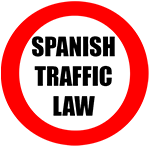Lane signs indicate special regulations for one or more road lanes.
The following can be cited:
S-50 a, b, c, d and e. Lanes reserved for traffic depending on the speed signalled. Indicates that the lane on which the minimum speed signal is located can only be used by vehicles travelling at a speed equal to or greater than the indicated speed, although if circumstances allow it, they must travel in the lane on the right. The end of the compulsory minimum speed will be established by the S-52 or R-506 signal.
S-51. Lane reserved for buses. Indicates prohibition of drivers of vehicles that are not of collective passenger transport to drive in the indicated lane. When taxis are mentioned, it also authorises taxis to use this lane. In the sections in which the longitudinal white mark is constituted, on the outer side of this lane, by a dashed line, its general use is allowed exclusively to perform any manoeuvre other than stopping, parking, changing the direction of travel or overtaking, always leaving preference to buses and, where appropriate, to taxis.
S-52. End of lane. Pre-warning sign the lane that will cease to be usable, indicating the necessity of a lane change.
S-52 a and b. End of lane. Pre-warning sign, on a two-way road, that the lane will cease to be usable, and indicates the precise lane change.
S-53. Change from one to two lanes of traffic. It indicates, in a section with a single lane in a direction of travel that in the next section there will be two lanes in the same direction of movement.
S-53 a. Change from one to two lanes of traffic with specification of the maximum speed in each of them. It indicates, in a section with a single lane of traffic in one direction, that in the next section it will now have two lanes in the same direction of movement. It also indicates the maximum speed that is allowed in each of them.
S-53 b. Change from two to three lanes of traffic. It indicates, in a section with two lanes in a direction of movement that in the next section there will be three lanes in the same direction of movement.
S-53 c. Change from two to three lanes of traffic with specification of the maximum speed in each of them. It indicates, in a section with two lanes in a direction of movement that in the next section there will be three lanes in the same direction of movement. It also indicates the maximum speed that is allowed in each of them.
S-60 a. Bifurcation to the left on a two-lane road. It indicates, in a road with two lanes of traffic in the same direction, that in the next section the lane on the left will fork towards that same side.
S-60 b. Bifurcation to the right on two lane road. It indicates, in a road with two lanes of traffic in the same direction, that in the next section the lane on the right will fork to that same side.
S-61 a. Bifurcation to the left on a three-lane road. It indicates, in a road with three lanes of traffic in the same direction, that in the next section the lane on the left will fork towards that same side.
S-61 b. Bifurcation to the right on a three-lane road. It indicates, on a road with three lanes of traffic in the same direction, that in the next section the right lane will fork to that same side.
S-62 a. Bifurcation to the left on a four-lane road. It indicates, in a road with four lanes of traffic in the same direction, that in the next section the lane on the left will fork towards that same side.
S-62 b. Bifurcation to the right on a four-lane road. It indicates, on a road with four lanes of traffic in the same direction, that in the next section the lane on the right will fork to that same side.
S-63. Bifurcation in four lane carriageway. It indicates, in a road with four lanes of traffic in the same direction, that in the next section the two lanes on the left will fork to the left and the two on the right to the right.
S-64. Bike lane or bicycle path attached to the road. Indicates that the lane on which the cyclist track signal is located can only be used by cycles. The arrows will indicate the number of lanes on the road, as well as their direction of movement.
